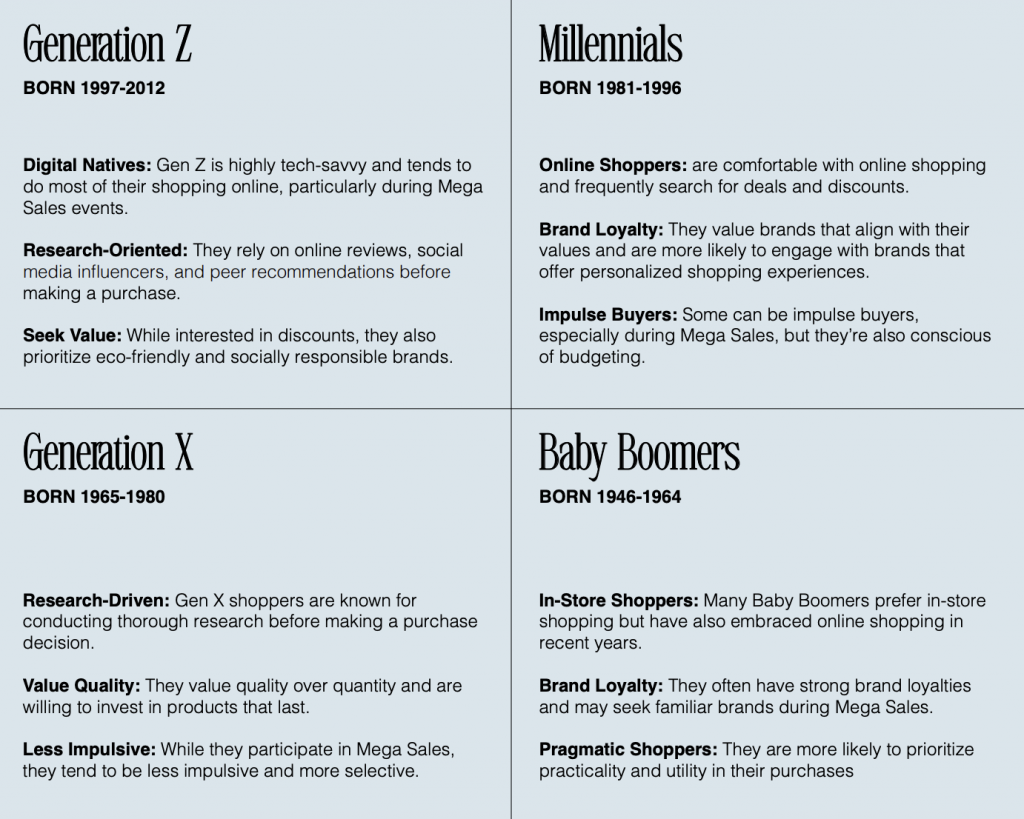Over 50% of users regret having bought on Black Friday or Cyber Monday.
That’s how everything started. That’s how we decided we needed not only to investigate the level of rejection of Mega Sales campaigns, but also to find out how a brand can still participate in these events without a backfire from their efforts.
In a world where retail is increasingly dynamic and challenging, big sales seasons have emerged as a captivating phenomenon that redefines the retail landscape during the last two months of the year. November and December bring together some of the biggest mega sales, combining consumerism, creativity and retail innovation, but they also take place against a backdrop of increasing consumer resistance to advertising, making the task of capturing attention and driving sales a formidable challenge for brands.
That’s why from Samy Alliance, and with over 50 Black Friday, Cyber Monday and Christmas campaigns executed in 2022 and 2021, we have conducted a comprehensive study to understand and address the complexities of this phenomenon which it has dubbed ‘Mega Sales’, identifying the top three challenges for brands and creating a roadmap for successful campaigns.
During Mega Sales, remarkable growth has been observed in key industries. In particular, the toys and children’s products sector has seen significant growth, largely driven by the baby boom generation, ranking third in terms of interest this year. On the other hand, the health and beauty industry has advanced to fourth place since 2022, thanks to make-up trends promoted by content creators and influencers and the reign of TikTok. Aside from this, fashion and footwear continue to be the most sought after and purchased items during Mega Sales.
In order to verify the statistics, the Mega Sales study includes a Social Listening conducted on the main social networks and digital media, as well as forums and blogs. The results show that in Latin America the most mentioned brands on Black Friday were Peugeot, Amazon, Casetify, Apple, Itau and Gamestop.
Mega Sales: a time to prepare
Consumers are preparing for the Mega Sales with the intention of reducing their spending despite the rising cost of living. In countries such as the UK, a 40% reduction is expected, while in nations such as Spain, France, Canada, Italy and the US, a 30% cut is anticipated. In addition, during the seasonal season, which includes Christmas and sales, searches account for a staggering 53% of the total.
However, despite the excitement, consumers also have significant concerns around the Mega Sale. 62% of shoppers express doubts about the authenticity of Black Friday sale prices, while 49% feel misled by the way deals are presented at this event. In addition, consumer expectations of Black Friday deals are rising every year, challenging retailers to rebuild trust in the credibility of offers and reimagine their advertising strategies.
What are users’ concerns and pains about Mega Sales?
- Lack of confidence in promotions: 62% of shoppers expressed doubts about the authenticity of Black Friday sale prices.
- Apathy creeps in: there is a huge challenge to maintain enthusiasm, with 49% of consumers feel cheated by the way Black Friday deals are presented.
- The Mega Sale dilemma: rising expectations and waning enthusiasm; with each passing year, consumer expectations of Black Friday deals rise. Retailers face the task of rebuilding trust in the credibility of the deals and reimagining their advertising strategies.
- Regret over “impulse shopping”: Consumers are attracted by deep discounts and tempting offers, and therefore managing the consequences of the sale is paramount. Statistics reveal that 67% of Generation Z have major shopping regrets at this time of year. This is followed by Baby Boomers, with 62% regret. However, the reality is that all generations experience post-purchase regrets of over 50%.
Different generations, from Z to Baby Boomers, have diverse shopping habits and expectations during Mega Sales, requiring brands to adapt to their specific needs. Preparing for success in these massive sales involves careful inventory management, efficient technology, shipping logistics, returns handling and, above all, an exceptional customer experience.
This contemplates starting the campaign even 4 weeks in advance, a tailored and divided influencer marketing strategy and well-papared e-mail communications.

How can brands prepare for Mega Sales?
Digital transformation is a necessity in this context, with 75% of Black Friday shoppers opting to shop online. This underlines the importance of robust website and app infrastructure, as well as real-time inventory tracking to avoid customer frustration. Mobile sales accounted for 48% of all online sales during Black Friday, an increase of 4% compared to the previous year.
Innovation is also key, as the online video format has become crucial, with 80% of shoppers switching between online and video search when looking for products to buy. In addition, not limiting yourself to a single day-focused strategy can result in a 104% increase in profits in the week following Black Friday.
The use of “Buy Now, Pay Later” (BNPL) has increased, but it is important to note that some consumers are using it even for lower-priced items, which is reflected in the 6% decline in the average value of BNPL purchase orders in the US during Thanksgiving. In addition, there was a notable 78% increase in orders placed via BNPL in the week of 19-25 November compared to the previous week.
Finally, other important considerations include shipping policy interest, post-holiday refund searches and spikes in “internet coupon” searches during Black Friday, reflecting a seasonal pattern linked to shopping events. In this evolving retail landscape, adaptability and the right strategy are essential for success in the Mega Sales.
In this evolving landscape, Samy Alliance urges brands to adapt and evolve, developing creative strategies that connect with consumers in an authentic way during the Mega Sales. With a deep understanding of consumer trends and concerns, brands can overcome the challenges and make the most of this commercial phenomenon. To do so, they need to rely on the tools that creative digital consultancies such as Samy Alliance can offer, including this guide to mega-sales campaigns.
If you want to read the full report, download here.

